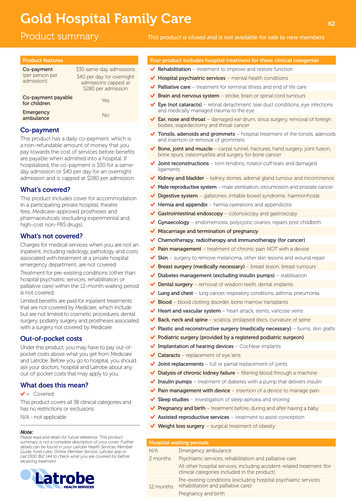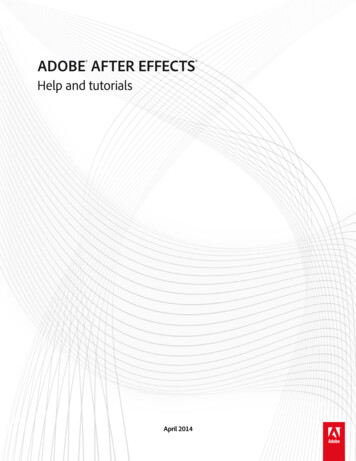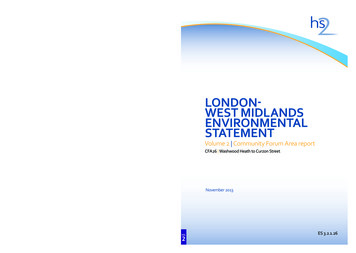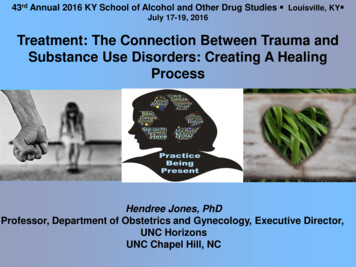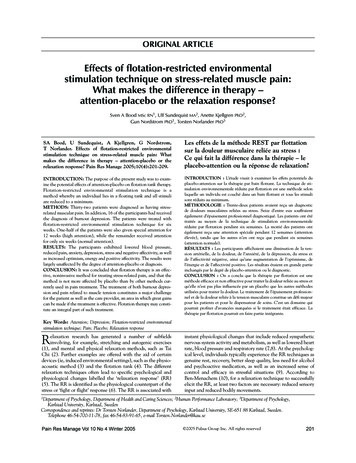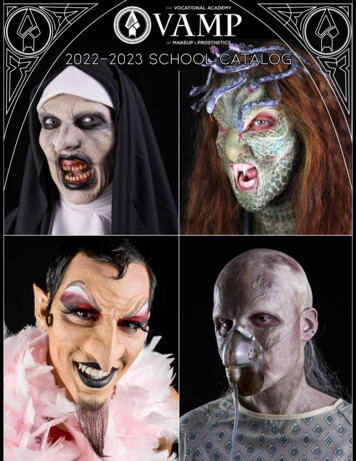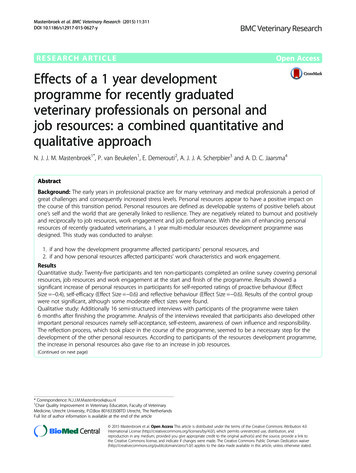
Transcription
Mastenbroek et al. BMC Veterinary Research (2015) 11:311DOI 10.1186/s12917-015-0627-yRESEARCH ARTICLEOpen AccessEffects of a 1 year developmentprogramme for recently graduatedveterinary professionals on personal andjob resources: a combined quantitative andqualitative approachN. J. J. M. Mastenbroek1*, P. van Beukelen1, E. Demerouti2, A. J. J. A. Scherpbier3 and A. D. C. Jaarsma4AbstractBackground: The early years in professional practice are for many veterinary and medical professionals a period ofgreat challenges and consequently increased stress levels. Personal resources appear to have a positive impact onthe course of this transition period. Personal resources are defined as developable systems of positive beliefs aboutone’s self and the world that are generally linked to resilience. They are negatively related to burnout and positivelyand reciprocally to job resources, work engagement and job performance. With the aim of enhancing personalresources of recently graduated veterinarians, a 1 year multi-modular resources development programme wasdesigned. This study was conducted to analyse:1. if and how the development programme affected participants’ personal resources, and2. if and how personal resources affected participants’ work characteristics and work engagement.ResultsQuantitative study: Twenty-five participants and ten non-participants completed an online survey covering personalresources, job resources and work engagement at the start and finish of the programme. Results showed asignificant increase of personal resources in participants for self-reported ratings of proactive behaviour (EffectSize 0.4), self-efficacy (Effect Size 0.6) and reflective behaviour (Effect Size 0.6). Results of the control groupwere not significant, although some moderate effect sizes were found.Qualitative study: Additionally 16 semi-structured interviews with participants of the programme were taken6 months after finishing the programme. Analysis of the interviews revealed that participants also developed otherimportant personal resources namely self-acceptance, self-esteem, awareness of own influence and responsibility.The reflection process, which took place in the course of the programme, seemed to be a necessary step for thedevelopment of the other personal resources. According to participants of the resources development programme,the increase in personal resources also gave rise to an increase in job resources.(Continued on next page)* Correspondence: N.J.J.M.Mastenbroek@uu.nl1Chair Quality Improvement in Veterinary Education, Faculty of VeterinaryMedicine, Utrecht University, P.O.Box 801633508TD Utrecht, The NetherlandsFull list of author information is available at the end of the article 2015 Mastenbroek et al. Open Access This article is distributed under the terms of the Creative Commons Attribution 4.0International License (http://creativecommons.org/licenses/by/4.0/), which permits unrestricted use, distribution, andreproduction in any medium, provided you give appropriate credit to the original author(s) and the source, provide a link tothe Creative Commons license, and indicate if changes were made. The Creative Commons Public Domain Dedication o/1.0/) applies to the data made available in this article, unless otherwise stated.
Mastenbroek et al. BMC Veterinary Research (2015) 11:311Page 2 of 13(Continued from previous page)Conclusion: The multi-modular resources development programme seems to support development of participants’personal resources. Because personal resources are beneficial in improving well-being irrespective of where anindividual starts working, it is important to give them explicit attention in educational settings.Keywords: Burnout, Resources development programme, JD-R model, Job resources, Peer group coaching,Personal resources, Transition, Veterinary, Work engagementBackgroundTransition from student to professional (whether veterinarian or medical), from a safe learning environment toa professional environment with great responsibilities,means entering a period of rapid personal and professional development, often characterized by elevatedlevels of stress [1–9]. Inadequate support, negative experiences, making mistakes and being overworked andunderpaid, can make the first year after graduation avery critical period in the career and lives of the recentlygraduated professional [1, 6, 9]. This applies not only forveterinarians but also for other medical health care professional such as nurses [10–12], residents and generalpractitioners [13–16]. Although many medical healthcare professionals, in contrast to veterinarians, enter astructured training programme after graduation frommedical school, research in this domain showed thatthey are struggling with the same problems. Apart froma negative experience due to increased stress levels, thetransition period can also be interpreted positively as challenging, full of learning opportunities and opportunitiesfor high performance [5]. In a study among recently graduated veterinary professionals, Mastenbroek et al. [17] investigated work-related well-being and its predictors inthe transition period, using the Job Demands-Resources(JD-R) model as a theoretical model [18, 19]. Their results showed that one in seven Dutch veterinarians islikely to be burnt-out within 10 years of graduation,while only one in eight veterinarians qualifies him/herself as highly engaged in that same period. Well-beingwas predicted by both work-related (job demands andjob resources) and person-related (personal resources)predictors [17].The JD-R model is an occupational stress model thatposits two broad categories of work characteristics: job demands and job resources [18, 19]. Job demands are aspects of work that require sustained physical or mentaleffort on the part of the employee and are thus associatedwith psycho-physiological costs. Examples are work-homeinterference, workload, job insecurity and role conflicts.Job resources are aspects of the work that are functionalin dealing with high demands and achieving occupationalgoals. They are also important in their own right as stimulants of personal growth [20]. Examples are, autonomy,feedback from work and support from colleagues andsupervisor. According to the JD-R model, job demands canevoke an energy depletion process, potentially leading to abreakdown (or burnout) when individuals fail to recoveradequately [21]. Job resources on the other hand, induce amotivational process, which can promote work engagement. In addition to job resources, we can also distinguishpersonal resources. Personal resources are developable systems of positive beliefs about one’s self and the world thatare generally linked to resilience, i.e. people’s sense of beingin control and able to influence their environment successfully [22]. This definition encompasses a feeling of beingappreciated and in control as well as skills and attitudesthat facilitate these feelings. Examples of personal resourcesare self-esteem, self-efficacy, optimism, and a pro-active attitude [17, 23]. Personal resources are negatively related toburnout and positively and reciprocally to work engagement and job resources [24] and to performance [25].Figure 1 presents the extended JD-R model (including personal resources) that we validated for the veterinary profession in an earlier study [25]. Job and personal resourceshave been found particularly beneficial for employees’ workengagement when job demands are high [26]. Because oftheir positive relationship to mental well-being, these personal resources are suggested to represent a target for interventions aimed at facilitating the transition period andincreasing the well-being of young veterinary professionals.For educators it is important to understand what cancontribute to a more positive progress of the transitionperiod [27]. The present study was conducted to analysethe effects of an intervention on personal resources: a1 year resources development programme was designedfor veterinary professionals who had graduated duringthe last 5 years, focusing on broadening and/or enhancing participants’ personal resources. The followingquestions were investigated:1. Are self-reported levels of personal and job resources and work engagement higher at the end ofthe intervention as opposed to their levels at thestart of the intervention?2. How did the programme affect participant’s personalresources?3. How did personal resources affect participant’s workand work environment and participant’s workengagement?
Mastenbroek et al. BMC Veterinary Research (2015) 11:311Page 3 of 13Fig. 1 The extended Job Demands–Resources Model [25]MethodsContextIn the Netherlands, students may register for veterinaryeducation at the Faculty of Veterinary Medicine afterhaving completed high school. The veterinary educationprogramme lasts for 6 years. After graduation, 75 % ofthe veterinary professionals (of which 80–85 % females)chooses for a career in veterinary practice. After a fewyears of working as an employee, they often continuetheir career in veterinary practice as a self-employed vet.The other 25 % prefer employment in industry, educational institutes, research or a job in the public domain.There is no formal additional training programme forthose who enter veterinary practice.Programme designIn 2010, the Royal Netherlands Veterinary Association introduced a resources development programme for youngveterinary professionals with the aim of enhancing workengagement by broadening and increasing participants’personal resources. Because the needs of participants arevarious, the programme was designed in a way that it enabled participants to set their own learning objectives andto work thereto during the trajectory. The modules varyregarding the input they provide for reflection and learning at different levels (i.e. context, behaviour, beliefs orcompetencies) [28]. In the course of this article, the ‘resources development programme’ will be referred to inabbreviated form as the ‘development programme’.The development programme consists of:1. An intake procedure including a talent assessment,collection of 360 feedback at the workplace andan intake meeting that serves to identify goals forimprovement and commitment to work on thesegoals throughout the programme.2. Various modules with an emphasis on reflection andexperimenting with new behaviour. All participantswere enrolled in the general programme.Participants met every 6 weeks for 10 months.Altogether, there were six training days. A trainingday consisted of three parts: a) looking back on thepast 6 weeks, b) intervision (peer-coaching) and c)half a day professional skills training. Each trainingday ended with updating existing learning objectivesor with preparing new ones. In the period betweentwo meetings, participants worked on their learningobjectives and applied new insights and skills intheir work. When necessary the general programmewas supplemented with individual coaching and Elearning modules. The programme was facilitated bytwo professional coaches.1Registration for the programme was open to all veterinary professionals having graduated between 0 and5 years. Recruitment of participants took place by meansof an electronic newsletter from the Royal NetherlandsVeterinary Association and through an announcementin the Netherlands Journal of Veterinary Science [29].There was no active selection of participants. Participation was voluntary and costs were about 2000 euro.This manuscript reports one study combining a qualitative and a quantitative part including an online surveyand semi-structured interviews.Quantitative studyProcedureMeasurements were taken at two different moments: atthe time of the onset of the development programme(Time 1), and 10 months later, when the developmentprogramme was completed (Time 2). On the first day ofthe programme an introduction to the research was held.
Mastenbroek et al. BMC Veterinary Research (2015) 11:311At this introductory meeting the goal of the study and theentire procedure was explained, addressing the confidentiality of the data. Participants of the programme wereasked to volunteer for our study. A day after the meeting,invitations to participate in the research were sent individually by e-mail to all participants of the developmentprogramme. The e-mail contained an internet linkwhich directed the participants to an online survey.Two and 4 weeks after the distribution of the questionnaire, reminders were sent by personalized e-mail.Participants who completed the questionnaire at Time1 received an invitation to complete the survey againat Time 2. The T2 questionnaire differed from the T1questionnaire with respect to one question that wasadded to the T2 questionnaire: we asked participantswhether anything had changed concerning the organisation they worked for. If participants had changedjobs and worked for another organization, the questions concerning job recourses were skipped, becausein that case job resources at T2 and T1 cannot becompared.ParticipantsIn total 46 participants (male/female: 9/37) enteredthe development programme in three groups startingin April 2010, September 2010 and July 2011. All participants completed the full programme. There wereno dropouts. The male–female ratio of participants tothe development programme was representative forveterinarians having graduated in the last 5 years.Thirty-three participants (response rate (RR) 72 %)completed the first questionnaire (Time 1). Twentyfive participants (RR 54 %) completed both questionnaires (Time 1 and Time 2) (male/female: 3/22, meanage: 29 years, mean work experience: 2.8 years, 22 persons were employed in veterinary practices consistingof an average of nine vets, and three were employed inother domains). We asked respondents to fill in thenames of two colleagues who did not participate in thedevelopment programme (preferably with the samesex, the same year of graduation, the same type ofwork, but working in another veterinary clinic). Thesecolleagues were approached to participate in the control group which serves as a measure for normal development over time in the first years of the career.The control group consisted of 22 veterinarians whowere invited to complete the survey. Eighteen persons(RR 82 %) completed the first questionnaire. Tenpersons (RR 45 %) completed both questionnaires(male/female: 1/9 mean age: 29 years, mean workexperience: 3.1 years, all ten persons were employedin veterinary practices consisting of an average ofseven vets).Page 4 of 13MeasuresPersonal and job resources were measured using 35 itemsof the Veterinary Demands and Resources Questionnaire(Vet-DRQ): five personal resource scales (Self-efficacy(SE), Reflective behaviour (REF), Optimism (OPT), Proactive behaviour (PRO) and Thoughtfulness (THO)), andsix job resource scales (Decision latitude (DL), Decisionauthority (DA), Skills discretion (SD), Support from colleagues (STC), Support from supervisor (STS), Feedbackfrom work (FB)) [30]. The Vet-DRQ is a questionnaire tailored to and validated for the veterinary profession, thatcan be used for measuring various job demands, job resources, and personal resources. The Vet-DRQ consists of22 scales. Alpha coefficients of all scales .70. Becausecompleting the Vet-DRQ is rather time consuming weopted for shortening the scales. Items were chosen on thebase of face validity. Responses on a five-point scale wereused for all job resources scales (1 never; 5 always) andfor all personal resources scales (1 I totally disagree; 5 Itotally agree).Work engagement (WE) was measured using the nineitem version (seven-point scale: 1 never, 7 always) ofthe Utrecht Work Engagement Scale (UWES) [31], withwork engagement as a one-dimensional construct andhigh scores indicating strong engagement.Background information consisted of demographic andoccupational details: age, gender, number of years sincegraduation, number of years of work experience.AnalysisThe mean scores of personal and job resources and workengagement at Time 1 were compared with those atTime 2 using ‘paired samples T-tests’ in SPSS version17.0 (SPSS Inc.). Effect sizes were calculated usingCohen’s d [32].Qualitative studyAdditional to the quantitative data collection, we conducted a qualitative study comprising individual semistructured interviews with participants of the developmentprogramme. The main objective of the interviews was tofind an answer to research question two (how did the development programme affects participant’s personal resources?) and three (how did personal resources affectparticipant’s work and work environment and participant’swork engagement?). In contrast to group interviews thathave a public nature, individual interviews allow to delvedeeper into personal experiences [33].ProcedureThe interviews were conducted 6 months after completingthe programme, allowing for the long-term effects to betaken into account. The interviews were semi-structuredwhich means that initial questions were formulated. After
Mastenbroek et al. BMC Veterinary Research (2015) 11:311Page 5 of 13the initial response of the interviewee, the interviewerasked new questions for clarification or to encourage theinterviewee to supplement the response. The questionswere prepared on the basis of the JD-R model. The interviews were conducted by the first author (NM) and lastedapproximately 1 h. All interviews were audio recorded.gave written informed consent in response to a letterthat explicitly stated that participation in the study wasvoluntary and that gave assurance of full confidentialityof the data. We adhered to the RATS guidelines forqualitative research [40]. A COREQ checklist is includedas an additional file ( Additional file 1).ParticipantsResultsThe 16 participants for the interviews were randomlychosen out of the participants who completed the firstquestionnaire. We sought to interview five persons per cohort. Depending on the number of participants who completed the first questionnaire in each cohort, we approachedevery second or third person on the list with the question ofwhether he or she consented to the taking of an interview.No invitee refused. The average age was 29 years (SD 2.9).Two out of sixteen interviewees were male.AnalysisWith the aim to increase internal reliability [34], transcriptions of the recorded interviews were independentlyanalysed by two of the authors (NM and PvB) by use ofdeductive, thematic analysis at a semantic level [35].This approach of the data is driven by theory, in thiscase the assumptions and a priori themes of the JD-Rmodel (i.e. job demands and resources, personal resources and work engagement). Following the guidelinesfrom King and Horrocks, the analysis of the data is donein three stages [34]. After familiarizing themselves withthe data by reading an interview as a whole, both researchers independently started coding the data firstlyby identifying codes that refer to personal aspects, secondly identifying codes referring to aspects of the job orthe work environment and ultimately identifying codesreferring to work engagement (descriptive coding). Inthe next phase the researchers sorted the different codesinto potential themes and collated relevant coded datawithin the identified themes. The potential themes werethen reviewed and discussed till agreement was reachedabout the themes, their meaning (interpretive coding)and how they fit together (overarching themes), whereafter they were named. Finally, quotes were selected toillustrate the themes.Ethical considerationsAt the time this study was set up, educational researchwas exempt from institutional board review by Dutchlaw [36]. It was designed to meet the Helsinki Declaration guidelines [37–39]. In the quantitative study confidentiality of the data was explained in the letter invitingthe veterinarians to take part in the survey. We explicitlystated that participation in the study was voluntary andthat no one else but the first researcher had access tothe raw data. For the qualitative study all intervieweesQuantitative studyParticipantsParticipants and non-participants of the programme didnot differ significantly concerning the mean levels of joband personal resources and work engagement at Time 1.Descriptive statisticsTable 1 shows intercorrelations and the internal consistencies (Cronbach’s alpha) of the variables included inthe analysis.Are self-reported levels of personal resources increased atthe end of the intervention as opposed to their levels at thestart of the intervention?In order to investigate this question, a paired-sampled ttest was used for five personal resources and six job resources. As can be seen in Table 2, a significant differencebetween Time 1 and Time 2 was found in participants forProactive behaviour (Effect Size (ES) 0.4, Self-efficacy(ES 0.6) and Reflective behaviour (ES 0.6). Results ofthe control group were not significant, although somemoderate effect sizes were found.Qualitative studySummary of resultsThe important themes that emerged from the interviewsseem to be the results of a reflection process that tookplace over the course of the development programme.The programme resulted in participants reporting increased personal resources such as self-acceptance andself-esteem (personal resources that we did not measurein the online survey), increase of proactive behaviourand increased self-efficacy. Subsequently they reportedan increase of perceived job resources and a decrease ofperceived job demands. Most participants mentionedthat their work engagement was unchanged or increased.Results have been illustrated by quotes (Table 3).How did personal resources increase during thedevelopment programme?Self-acceptance and self-esteemThrough sharing of experiences, corresponding feelingsand thoughts, in the context of the peer coaching meetings, participants recognized that they were not alone intheir uncertainty and in doubts concerning their abilities
N1231. DL T121 (.77)2. DA T121 .708** (.86)3. SD T121 .019 .1774. STC T121 .218.481*.3385. STS T121 .122.339.2376. FB T121 .198 .160 .17445678910111213.42817(.70)25 .000 .020 .208.111.173.121(.79).212 .163.109.252.146.717** (.84)9. OPT T125 .439*.403 .068.285.326.140.631** .613** (.83)10. REF T125 .034.053.016.141.418.293.569** .527** .711** (.85)11. THO T1 25 .032 .121 .046.190.072.303.458*.426*.339.265( 413. DL T221 .768.572 .010.05914. DA T221 .548*.521* .073 .007 .095 .195 .13115. SD T221 .328.285.521*.092.118 .160 .297 .054 .006 .025 .236 .090 .088.373(.74)16. STC T221 .180.151 .175.061.079 .208 .377.533.126.169.300(.76).440*.359.207 .036.074.719** (.92).466*.196.388.03017. STS T221 .565.269 .291 .185 78)18. FB T221 .473*.253.177 .019 .676** (.73)19. PRO T225 .182.058 .222.154 .042 .082 .675** .410*.624**.436*.311.220 .200 .134.318.049(.86)20. SE T225 .319.228.132.449*.195 .061 .258.221.069.002.304.057.131.090.087**21. OPT T225 .306 .238.407.040 .090 .50522. REF T225 .153 .055 .040.100.036.14623. THO T2 25 .229 .200 .06324. WE T221 .376.22021222324(.91) .045 .487*25 .141.12616(.86)8. SE T121 .26615( .01)7. PRO T112. WE T114 .078 .148 .192.252.028 .049 .291*.218(.53).682.310.359.337.171 .063 .159 .067.605.179(.75).664** .578** .425*.427*.238.468*.025.061 .276 .038 .077 .236 .358.067.277(.75).273 .026 .204 .251 .228 .098 .221 .441.247.099.551** (.77).266.198.257* .064 .051 .039.250.557** **.593.319Mastenbroek et al. BMC Veterinary Research (2015) 11:311Table 1 Intercorrelations between the study variables and Internal Consistencies (Standardized Alpha’s-on the diagonal).112(.90)T1 Time 1, T2 Time 2, *p .05. **p .01Page 6 of 13
Mastenbroek et al. BMC Veterinary Research (2015) 11:311Page 7 of 13Table 2 Paired sample t-test results for personal and job resources, and work engagement on Time 1 (T1) and Time 2 (T2) inparticipants and non-participants (Standard deviations in brackets)ParticipantsNon-participantsNMeans at T1Means at T2Effect sizeNMeans at T1Means at T2Proactive behaviour252.89 (.67)Selfefficacy25Optimism25Reflective behaviourThoughtfulnessEffect size3.18 (.63) 0.4*102.83(.53)3.15 (.64) 0.53.37(.79)3.76 (.43) 0.6*103.73(.34)3.83 (.39) 0.33.68 (.85)3.92(.74) 0.3104.05(.54)3.92(.54)0.2253.51(.82)3.88(.41) 0.6*103.67(.63)3.77(.52) 0.2254.14(.40)4.18(.63) 0.1103.95(.50)4.15(.34) 0.5Decision )0.2Decision authority213.00(.69)3.16(.79) 0.293.15(.87)3.52(.50) 0.5Skills discretion213.52 (.45)3.46(.59)0.193.59(.60)3.52(.75)0.1Support )0.1Support 3)0.0Feedback from work212.81(.55)2.76(.73)0.192.70(.35)2.93(.62) 0.5214.48(1.06)4.61(.85) 0.194.99(.56)4.89(.83)0.1Personal resourcesJob resourcesWork engagement*p .05or learning capacities. This allowed a different perspective on the personal situation (A). They became aware oftheir own thoughts, the areas of tension, and of having achoice whether or not to allow limiting factors to determine their behaviour (B). By analysing their own thoughtsthey realized that these thoughts caused a great deal ofstress and they then learned to replace these by more constructive thoughts (C). The reflection process resulted inparticipants reporting increased self-acceptance andself-esteem. Participants mentioned that they felt lessstressed (D).Proactive behaviourParticipants became aware that they always have achoice in acting and learned that they can affect situations (3, 4, 12). They learned to take responsibility fortheir way of working and living (2, 8, 9, 15) and whatprevents them achieving the desired situation or fromrealizing their stronger sides (7). They learned to copeactively, be proactive and use their influence with theaim to make change happen.Self-efficacy and optimismTraining of specific skills in the course of the development programme supported participants in actuallydeploying new behaviour. Examples of learned skillswere ‘giving constructive feedback’, ‘refusing a request’,‘engaging in conflicts’, ‘leading a conversation or chair ameeting’ (E). When new behaviour was carried outsuccessfully, it strengthened their belief in their personal efficacy and their optimism. This helps theparticipants to break away from old patterns and fosters their optimism (F).How did these personal resources affect participants’ workand work environment and participants’ work engagement?Perceived effects of increased self-conscientiousness andincreased self-esteemAccording to the participants, the reflection process, ofwhich increased self-consciousness, an awareness of ownneeds and increased self-esteem resulted, had various effects on job resources and job demands: they mentionedthat their communication with clients and colleaguesimproved, they communicated more and at an earlierstage (1, 4), they perceived increased support from theirsupervisor (5, 10) and experienced improved relationships with colleagues (5, 7) and clients (11). They mademore use of decision authority afforded by their employer (4, 5, 10), and their work-life balance improved bysetting limits to workload or by prioritizing tasks (2, 4,10, 14, 13). Sometimes the reflection process made themaware that their job did not (yet) fit their needs (1, 11,13) or indeed fitted their needs and competencies verywell (7, 3) (G).Perceived effects of proactive behaviourThe effect of increased awareness of one’s own influenceand consequently developing a proactive approach towork and work environment is also noticeable with respect to job demands as well as job resources. Participants experience an improved work-life balance through
Mastenbroek et al. BMC Veterinary Research (2015) 11:311Page 8 of 13Table 3 Quotes from interviews. Capitals between brackets correspond to capitals in text. Numbers between brackets refer toparticipants in the studyQuotesA “Swapping experiences with others and hearing their stories was very fruitful, how they, experienced their first years as vets, so to speak. Realizingthat everybody has ups and downs and you aren’t the only one going around with uncertainties. I was thinking. well, it should get better everyyear, until you can do everything.” (1)B “Being a perfectionist is, like, not being allowed to make mistakes. That was more when I started work. Then you had the idea, my goodness, if Ido this, then that happens and the animal dies, the client will be mad at me and then I’m a worthless vet.”(10)“And I’ve learned to recognize my own thinking patterns and if I get into a negative spiral I’ve learned to recognize it and to get myself out of it.Or at least, I know roughly how to get out of it. I don’t know if I’ll get out of it but at least I can see when I am in it.”(5)C “As well, because I tell myself, OK, I do my work, I do my very best, I do it as well as I possibly can, so it’s less stressful if I make a wrong decisionaccording to the owner, because I can still tell myself that I thought that was the best decision at the time and that’s why I made it.“(1)D “Yeah. like, especially that your own opinion counts and that if somebody has a big mouth and always shuts you down, it doesn’t mean that’sthe truth, but you can say, OK, wait a minute, I think differently and that you dare to say it. You can just say calmly I don’t agree and this is why Idon’t agree and it doesn’t have to lead to a conflict. Partly competence and partly realizing that my opinion counts too.” (4)E Refusing a request: “I realized that refusing a request is a good op
resources, job resources and work engagement at the start and finish of the programme. Results showed a significant increase of personal resources in participants for self-reported ratings of proactive behaviour (Effect Size 0.4), self-efficacy (Effect Size 0.6) and reflective behaviour (Effect Size 0.6). Results of the control group


